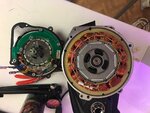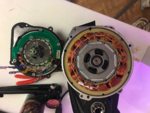I have been studying E-bike drive systems for sometime now. I find it amusing that so many people just go by what they read in the brochures. Especially, the Torque ratings!
Yet the subjective experience is nowhere near to the corresponding values. To put in crude, vulgar terms, It is like you're courting a girl and you decided to pursue her because this girl has 32B, 36DD.. etc
Torque rating is just one of the parameters and how the overall system is designed is much more important than one single parameter. The algorithm, controller design, power draw etc matter more than just "Torque". A system could have more torque but at what expense? power? less speed?
Bosch - 60Nm and now upped to 70Nm.
Derby Impulse 2.0 - 80Nm (newer RS versions)
TranzX mid drive - 73Nm
BBS-02 - 120Nm
M1 Pin Drive - 120Nm
Dapu - 40Nm
Currie electro drive - 42Nm
Stromer SYNO drive - 35Nm
I could go on...
Why is it misleading?
I have called tech people and even those who design the drive systems to find out how they measure these Torque ratings and the response was appalling. They have no clue!!
Is this measured at the wheels?
at the derailleur? (if so, is it amplified because of gears?)
at the hub?
Out of all mid-drives I have tested only two systems stand out in terms of Torque ( BBS-02 and M1 Pin dirve), rest have been very subdued experience.
You run any of the mid-drives at 23mph on a slight incline (3-4% grade) and see the range! and compare it to efficient hub drives. You won't notice any difference and in fact, given the specs, you'll see far less range than advertised.
Mid-drives supposedly get more range
because they make you work like donkey. The mid-drives don't over exert and are extremely conservative in terms of power output (exception of few mid-drives I mentioned above).
So, all I can say is -
Beware of bombastic sounding blowhard people (if it's me, so be it). Is the claim backed up with some real data that can be verified? Is that a credible source?
Most importantly , test drive several bikes. Take it out for extended 24 hour test drives and put it through some vigorous testing. It's worth it. You'll learn a lot and not yield to marketing gimmicks.
Anyhow, the point is to educate yourself. At the end of the day, all you want is reliable E-bike to do 30 mile rides? most bikes would suffice. If you're a geek like me, you'll want to tear it apart and keep learning

Enjoy




